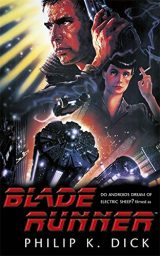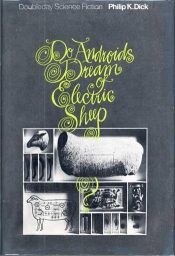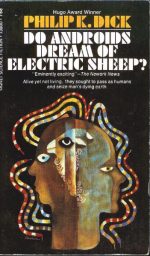 The movie Blade Runner (1982) was the first cinema adaptation of Philip K. Dick based on his novel Do Androids Dream of Electric Sheep? Last month, I picked up the novel out of town at a Half Price Books. The store had a few copies of a U.K. Orion Books trade paperback edition.
The movie Blade Runner (1982) was the first cinema adaptation of Philip K. Dick based on his novel Do Androids Dream of Electric Sheep? Last month, I picked up the novel out of town at a Half Price Books. The store had a few copies of a U.K. Orion Books trade paperback edition.
Do Androids Dream of Electric Sheep? was published in 1968 by Doubleday in hardback. It got a Hugo nomination. Signet reprinted the book as a mass-market paperback in 1969. There was a 2nd printing in 1971 and then the book was not in print until the movie in 1982.

The novel takes place in 1992 in earlier editions. That was changed to 2021 in later editions. A nuclear war (World War Terminus) has poisoned the Earth with radioactive dust. There is an extinction event with quite a bit of animal life dying off. Most humans have moved to colonies off planet. Staying on Earth will eventually result radiation poisoning with genetic damage. Androids (“andys”), manufactured humans, are used in the colonies for labor. There is also a religion called “Mercerism,” based on empathy. There is a counter religion and T. V. show, Buster Friendly that is against Mercerism.
They escape to Earth where they are hunted down and “retired.” There is a problem with Nexus-6 androids that have more sophisticated brains. Bounty hunters hired to retire androids generally tell them from regular humans through empathy tests.
Rick Deckard, the Harrison Ford character from the movie, lives in San Francisco in an apartment building. His wife is an emotional wreck. She misuses the “mood organ device” that dials up or down emotion. Deckard travels to Seattle to Rosen Industries to administer the empathy test on the Nexus-6 series. While there, he is introduced to Rachael, Eldon Rosen’s niece.
There is a section with bounty hunting and an escape with another bounty hunter from a police station filled with androids. The novel switches to scenes with J. R. Isidore, who becomes involved with a group of escaped androids that Deckard is after. Deckard uses Rachael to help him while the androids use Isidore to help trap Deckard.
There is a climax of Deckard setting a near record for retiring androids in one day. He goes back to his wife and finds that Rachel killed his pet sheep that he had bought with bonus money retiring androids.
A big part of the novel is the quest to own an animal. Social status is based on pets or owning an animal. The movie Blade Runner does not have any of the animal owning part, Mercerism, or Buster Friendly. A part of the novel, bounty hunting androids was retained and refitted as what has been called “neo-noir.”
I have to say reading the novel Do Androids Dream of Electric Sheep? was again, not a pleasurable experience. Dick’s world dying from radioactive dust was nothing new after reading The Philip K. Dick Reader. The writing, especially the dialogue was better than his 1950s science fiction digest magazine stories. I don’t know if I ever watched the movie the whole way through. It seemed like it was on cable constantly around 30-35 years ago. I just could not sit myself down to watch it in one sitting. It did not hold my attention.
The novel has Dick’s 1950s concerns with a few 1960s updates, mainly the religion aspect and more delving on what it is to be human. Maybe I will watch the movie in one sitting finally if I see it on T.V.

Fundamental difference is Rick’s nature in the movie. Plus the movie loses the whole empathy theme half way thru.
Did you feel like mercerianism and the androids represent something, allegorize a key relationship in the mass media of today?
One error and some things missed…
The Animal Owning does appear in the movie. It’s why Zhora tells Deckard: “Do you think I’d be working in a place like this if I could afford a real snake?” It is not as developed as it is in the book however (but more on that later).
The conflict in the movie is between android and human, the underlying question being “What does it mean to be human?” The conflict in the book is more complicated and multi layered as it adds the Fred Friendly Johnny Carson style talk show to the mix. It’s a 24 hour SECULAR counterpoint to Mercerism, which is a RELIGION that can only be experienced by a television/video hook up (the “mood organ” you mention).
The SECULAR talk show is, of course, allied with the Androids whose world view is purely mechanistic. Mercerism, by contrast, involves faith in the form of induced religious ecstasy (emotion, empathy, etc). The Androids don’t understand that. They find it irrational and seek to destroy it by debunking it. In a sense they do for it develops that Mercer was a skid row drunk who was simply paid to appear on camera by those who created Mercerism and loaded his image into the mood organ. (Such is how I remember it anyway, though I’ll admit it’s been years and I may be off on a few details).
One other key difference between book and movie, before I return to the topic of animals: The Rachael of the book is a villain. She is the identical twin/model of Pris and only sleeps with Deckard so that his hesitation, when confronting Pris, will make him easier to kill.
Now animals: In the novel they serve as a key dividing point between humans and androids because the former crave the natural order and feel empathy for life while the latter cannot.
Hence the tortoise in the empathy (Voight-Kampf?)test. A true human will feel empathy with the tortoises plight while an android will not. In the book that’s further developed by the scene with Pris and the spider. Rather than feel wonder or empathy she proceeds to cut off it’s legs because she can’t figure out why it needs eight of them when, logically and mechanistically, she figures it should only need four. That, in the context of the novel, is almost as horrific an act as Rachael throwing Deckard’s sheep off the roof. Needless to say neither scene ended up in the film as audiences wouldn’t have understood the meaning at all.
Then comes the conclusion of the novel, which is totally opposite that in the film. In the movie the unicorn dream (directors cut only), and unicorn origami, communicates that Deckard is, in fact, an android himself.
Not so in the novel where Deckard goes off into the desert where he experiences a religious epiphany of sorts. He sees a vision of Mercer (now debunked, remember?) which leads him to a horned toad — perhaps the last one alive on earth. Excited, Deckard rushes it home, only to discover that the critter is actually fake, an android just like Zhora’s snake.
BUT…it doesn’t affect the reality of his religious experience. He adopts it anyway and accepts the spiritual reality of his experience in spite of the physical evidence against it. BELIEF I guess you could call it. Ergo he IS human, NOT an android; thus answering a question that had been raised in the books middle section when he’d encountered the other Blade Runner.
A very complicated novel. The movie gets the look right, and borrows much of the original dialog, but it only covers the surface elements, not all the underlying meanings.
The graphic novel has the entire text of the novel. It’s fantastic.